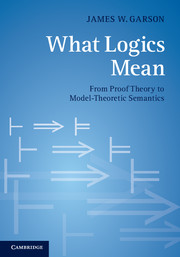Book contents
- Frontmatter
- Dedication
- Contents
- Preface
- Acknowledgements
- 1 Introduction to model-theoretic inferentialism
- 2 Deductive expression
- 3 Local expression
- 4 Global expression
- 5 Intuitionistic semantics
- 6 Conditionals
- 7 Disjunction
- 8 Negation
- 9 Supervaluations and natural semantics
- 10 Natural semantics for an open future
- 11 The expressive power of sequent calculi
- 12 Soundness and completeness for natural semantics
- 13 Connections with proof-theoretic semantics
- 14 Quantifiers
- 15 The natural semantics of vagueness (with Joshua D. K. Brown)
- 16 Modal logic
- Summary
- References
- Index
7 - Disjunction
Published online by Cambridge University Press: 05 June 2014
- Frontmatter
- Dedication
- Contents
- Preface
- Acknowledgements
- 1 Introduction to model-theoretic inferentialism
- 2 Deductive expression
- 3 Local expression
- 4 Global expression
- 5 Intuitionistic semantics
- 6 Conditionals
- 7 Disjunction
- 8 Negation
- 9 Supervaluations and natural semantics
- 10 Natural semantics for an open future
- 11 The expressive power of sequent calculi
- 12 Soundness and completeness for natural semantics
- 13 Connections with proof-theoretic semantics
- 14 Quantifiers
- 15 The natural semantics of vagueness (with Joshua D. K. Brown)
- 16 Modal logic
- Summary
- References
- Index
Summary
It has been relatively easy to locate a natural semantics for propositional logics that involve connectives other than disjunction. Discussion of disjunction has been postponed because the situation here is more complicated. It is possible to locate a condition ‖∨‖ on models that the rules for disjunction express (Section 7.2). However, it is unfamiliar; ‖∨‖ is neither the classical condition nor the intuitionistic reading of ∨ that was introduced by Beth (Section 7.1). Furthermore, there is reason to worry whether ‖∨‖ qualifies as a recursive characterization of truth conditions (Section 7.3). So it will be necessary to try to rescue ‖∨‖ (if we can) with a new isomorphism result. In Section 7.4, a variant of the Kripke semantics will be introduced (called path semantics) that includes an additional structure used in the disjunction truth condition. An isomorphism is shown to exist between the models in path semantics and models that obey ‖∨‖ (Section 7.5). This goes part of the way towards legitimizing the condition expressed by the disjunction rules as qualifying as a semantics. However Section 7.6 demonstrates that neither functionality nor a desirable form of compositionality holds for ‖∨‖. So whether the isomorphism result goes far enough to offset this pathology is in doubt. Whether we should accept ‖∨‖ as a legitimate reading for ∨ will be something left for the reader to judge.
- Type
- Chapter
- Information
- What Logics MeanFrom Proof Theory to Model-Theoretic Semantics, pp. 81 - 104Publisher: Cambridge University PressPrint publication year: 2013



